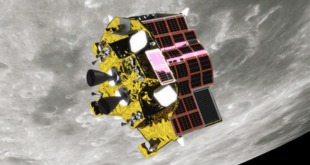
On Friday, 29 June 2018, Filipino Cubesat, Maya-1, started its journey to orbit when it was carried to the International Space Station (ISS) on the SpaceX Falcon-9 CRS 15 rocket. The cubesat will be deployed into orbit from the ISS in early August 2018.
Maya-1 was designed and constructed by two young Filipino engineers, Adrian Salces and Joven Javier, and was built at the Kyushu Institute of Technology (Kyutech) in Fukouka, Japan, as part of the multinational Birds-2 project. The cubesat is one of three that has been created as part of the initiative. Bhutan has also built Bhutan-1 and Malaysia has manufactured UiTMSAT-1. Salces and Javier took a year and three months to build the nanosatellite which is just 10 cubic centimetres in size, weighs 1-kilogram and was constructed using off-the-shelf components. Salces and Javier developed Maya-1 under the Development of Philippine Scientific Earth Observation Microsatellite program (PHL-Microsat), a research and development project implemented by UPD and the Department of Science and Technology-Advanced Science and Technology Insitute (DOST-Asti).
The satellite has been independently made, but the operation and control of the three satellites will shared between the three countries.
“The three will form a constellation, orbiting the earth from different places. This will provide the countries more opportunities to make measurements and run experiments, than just with using one cubesat,” explained Joel Joseph Marciano Jr., manager of PHL-Microsat program and director of DOST-Asti.
Its mission includes an automatic packet radio service digipeater, allowing it to communicate with ham radios used by amateur radio operators and enthusiasts. It also has a store-and-forward system, which can collect data from ground sensor terminals, and save and forward the data to any member ground station. Maya-1 will also provide a very useful backhaul service so that text messages can be sent from remote areas. This will also prove useful in the aftermath of typhoons which often bring terrestrial infrastructure down. The three Birds 2 cubesats are also equipped with a low-cost Global Positioning System (GPS) chip, a magnetometer (to measure magnetic fields in space), and wide-angle and narrow-angle cameras for capturing low-resolution images and videos. The construction and launch cost around U.S.$150,000.
The Philippines has big ambitions in space and is using the Birds 2 experience as a foundation to develop its indigenous satellite manufacturing capabilities. Once they finish their programmes at Kyutech, Salces and Javier plan to return to the Philippines to teach and to share with Filipino students and engineers what they had learned to build a generation of space engineers in the country. Both Maya-1 and Diwata-1, its predecessor, were manufactured in Japan so the plan is to create a completely indigenous satellite in the near future.





